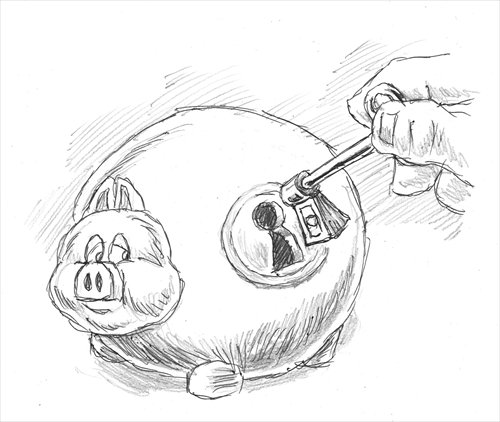State investment is key to global economic growth

Illustration: Peter C. Espina/GT
The world's two most rapidly growing major economies are China and India. Both countries show a common pattern of development which differs sharply from the slow growth seen in Western economies. China and India's expanding economies both feature rapidly growing state investment with slow or declining growth in private investment. In contrast Western economies have been relying on private investment but have seen limited growth in state investment. There is a reason why rapid expansion in state investment correlates to fast economic growth, while reliance on private investment leads to slow growth.
This reality will be crucial for China's practical economic policy as it seeks to achieve its goal of becoming a moderately prosperous society by 2020 and a high income economy by World Bank standards shortly thereafter. This should also help clarify recent discussions about the role of state and private investment in China's current economic development.
According to neoliberal doctrine and the Washington Consensus, private investment is "good" while state investment is "bad." However, the facts show that the exact opposite is true.
In 2015 per capita GDP growth in China and India was 6.4 percent and 6.3 percent on World Bank data, respectively. These are easily the fastest growth rates for any major economies. In the same year, EU per capita GDP growth was only 1.7 percent, the US 1.6 percent, and Japan 0.6 percent.
The causation between state investment and fast economic growth, and private investment and low economic growth is clear.
Likewise it is implausible that it is rapid growth which is responsible for the high levels of state investment in China and India, and low growth that has caused the low levels of state investment in the US. State investment is directly under the control of the government and not subject to market forces. Both the Chinese and Indian governments have made it clear that they have deliberately increased state investment in order to stimulate economic growth, while the US is ideologically opposed to state investment.
Earlier this year, China deliberately stepped up its level of state investment in several programs, particularly in infrastructure. By May the infrastructure investment action plan included 303 projects covering railways, highways, waterways, airports and urban rail transit, 131 of those projects are set to begin in 2016. This rapid buildup in state investment has been a deliberate measure to stabilize China's economy and prevent further downturn following the recent slowdown in growth. In India the Modi government appointed as its chief economic adviser a specialist on China's economy - Arvind Subramanian, formerly of the Peterson Institute for International Economics and author of Eclipse: Living in the Shadow of China's Economic Dominance. As soon as Subramanian assumed his position in October 2014, he made it clear that he saw state investment as the key to India's growth.
In the US, however, the ideology is that state is bad, while private is good. Because of this the US rejects significant state investment and does not possess the structures capable of delivering a rapid buildup of state investment.
Turning to the interrelation of these trends with the new normal in China, it is well known that a key feature of the new economy will be growth that is lower than the 9-10 percent annual rates seen for several decades after 1978 and which allowed the country to regularly set an annual growth rate target of 8 percent. Part of the reason for this is the extremely slow growth in the international economy. This global new normal was accurately described by IMF Managing Director Christine Lagarde as a "new mediocre."
However, the slowdown in China is far less severe than in advanced Western economies. From 2007-2015 annual average per capita GDP growth in the US was only 0.5 percent, in Japan 0.2 percent, and in the EU 0.1 percent.
There is no doubt that the reason for this extremely slow growth in Western economies was because of the low rate of growth of fixed investment. By 2015 the level of fixed investment in all Organisation for Economic Co-operation and Development (OECD) economies was still below 2007 levels. The reason for this, as in the US, was that state investment failed to rise rapidly in order to compensate for stagnating or falling private investment. In contrast China and India, by rapidly raising state investment, were able to achieve higher growth rates.
These global facts have clear implications for China's economic policy. Comparisons show it is clearly correct for China to have undertaken a policy of increased and targeted state investment. Any policy relying on private investment would have clearly been unsuccessful as the experiences of the US, Japan and EU confirm.
This economic reality is not a reason for not stimulating private investment. However, the global trends clearly show that state investment will continue to play a key role in China's economic development.
President Xi Jinping was correct in an earlier economic discussion, when he said that economic success in China required both the invisible and visible hand.
China's economic policy, however, is not about running a university class but about properly guiding the world's second largest economy on which the fate of 1.3 billion people depends. The adoption by China of the false economic position of "state bad, private good" would under all circumstances be damaging. But an adoption of such a flawed policy in the present global conditions would result in particularly rapid and severe damage.
The author is senior fellow at Chongyang Institute for Financial Studies, Renmin University of China. bizopinion@globaltimes.com.cn